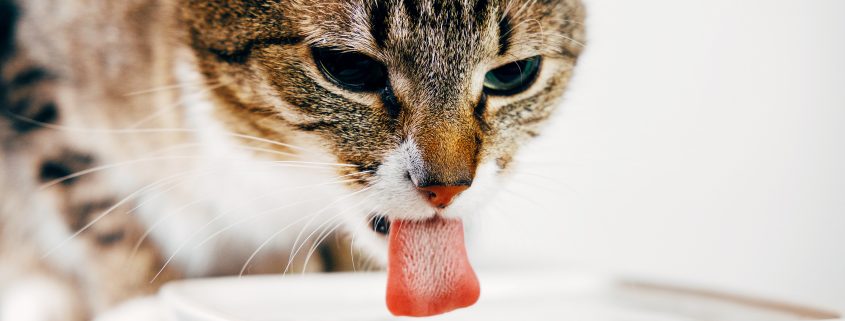Talking about cat hydration may not seem exciting, but it is an important topic for any cat parent. Dehydration is nothing to sniff at! In fact, it’s a serious medical issue. The good news is that there are several creative ways to encourage your cat to drink enough water so that they can stay healthy and hydrated. Unfortunately, this is easier said than done. That is why, in this blog, we share some of our tips and tricks to help you increase your cat’s water intake.
Signs that Your Cat May Be Dehydrated
There are several signs of dehydration; a few of the most common ones include:
- Dry gums
- Panting
- Lethargy
- Loss of appetite
- Sunken eyes
- Producing less urine than normal
Tips to Increase Water Intake
Have multiple bowls – Place multiple bowls throughout your home, so your cat doesn’t have to travel far to find water. A water bowl on every level is particularly useful for lazy cats or older cats that have difficulty moving.
Make sure water is clean and fresh – Clean, fresh water is vital for cats. Ideally, their water should be changed every day, with their bowls being cleaned at the same time. Their water bowls should be filled almost to the brim, so they don’t need to put their head too deep inside the bowl. Doing so will help them feel safer as they have a clear view while drinking and it helps prevent their whiskers from touching the sides of the bowl.
Try out a water fountain – Electric water fountains are a good way to get some cats interested in water and they circulate to help keep the water fresh. Just be sure to clean out the filter regularly (at least weekly or as directed by the product instructions), as bacteria can otherwise build up and discourage your cat from drinking.
Feed a partial wet food diet – If your cat only eats dry kibble, start incorporating wet food into their diet. Wet food isn’t just a special treat for your cat, it can actually be a key player in their hydration, particularly as they grow older and become more susceptible to kidney problems. Most canned foods contain 78- 82% water, providing your cat with hydration without them even knowing it.
Add some flavor – A few drops of tuna juice poured over your cat’s kibble can be a great way to sneak some extra moisture into their diet. Occasionally you could also add a small amount of low-fat, low-sodium broth (chicken or beef) to your cat’s water bowl to tempt your cat to drink more water.
What to Do if Your Cat is Dehydrated
If you suspect your cat isn’t drinking enough water, try some of the tips discussed above. If these don’t seem to work or if your cat exhibits any of the warning signs of dehydration, it may be time for a trip to the veterinarian. Your cat’s doctor will do an examination and run some diagnostic tests to determine if your kitty is dehydrated or not.
If your cat is dehydrated, immediate medical attention is required to both identify the underlying cause and to begin to correct your cat’s hydration level. Left untreated, dehydration can cause serious secondary health issues. If you are concerned at all that your cat may be dehydrated, the best first step is to call your veterinarian immediately!
Your Pets are our Priority!
And there you have it! The NASC ultimate guide to the essential cat travel accessories. At the National Animal Supplement Council, our number one priority is to promote the health and wellbeing of your pets. That is why we created the NASC Audit Program and the Quality Seal, which helps you identify animal health and nutritional supplements that come from responsible suppliers committed to producing the highest quality, most consistent products available. Visit our website to learn more and to see a list of NASC members that have earned the Quality Seal.


